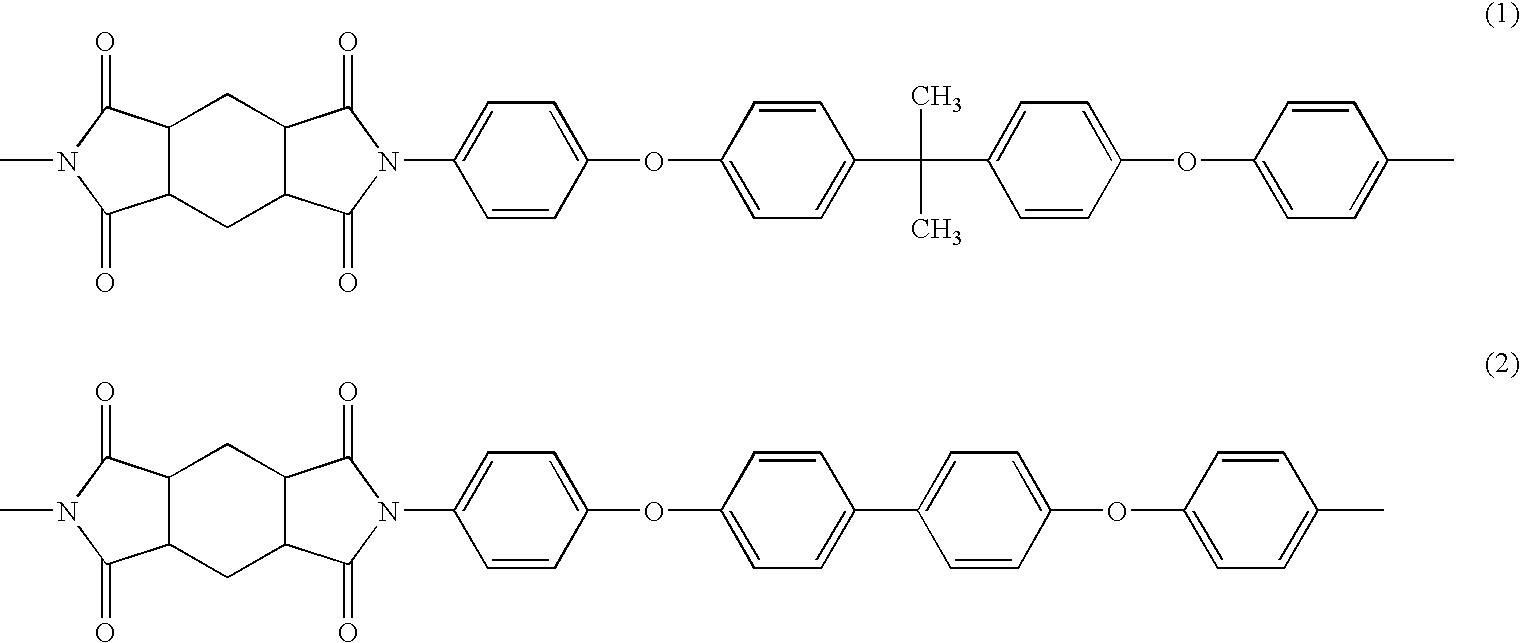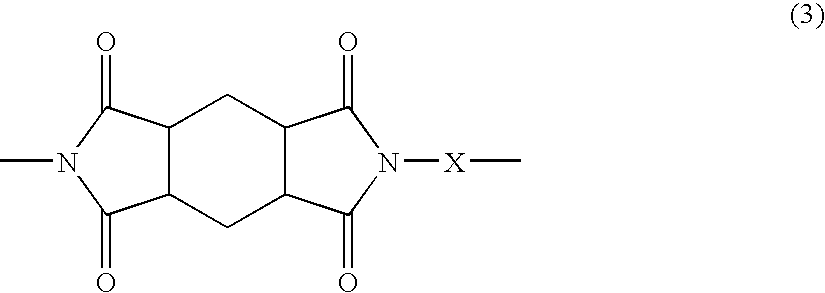Polyimide resin
a technology of polyimide resin and polyimide, which is applied in the field of polyimide resin, can solve the problems of hindering the adhesive properties between the insulating base material and the metal layer, water is especially regarded as a problem, and the heat resistance of a product after bonding becomes insufficient, and achieves satisfactory heat resistance, excellent adhesive properties, and low water absorption coefficient.
- Summary
- Abstract
- Description
- Claims
- Application Information
AI Technical Summary
Benefits of technology
Problems solved by technology
Method used
Image
Examples
example 1
[0079]In a 300-mL five-necked glass-made round bottom flask which was provided with a Dean-Stark equipped with a stainless steel-made semicircular stirring blade, a nitrogen introducing tube and a cooling tube, a thermometer and a glass-made end cap, 27.19 g (0.06624 moles) of 2,2-bis[4-(4-aminophenoxy)phenyl]propane (BAPP, manufactured by Wakayama Seika Kogyo Co., Ltd.), 50.00 g of N-methyl-2-pyrrolidone (NMP, manufactured by Mitsubishi Chemical Corporation) and 0.32 g of triethylamine (TEA, manufactured by Kanto Chemical Co., Inc.) as a catalyst were stirred under a nitrogen atmosphere at 100 rpm, thereby obtaining a solution.
[0080]14.11 g (0.06293 moles) of 1,2,4,5-cyclohexanetetracarboxylic dianhydride (HPMDA, manufactured by Mitsubishi Gas Chemical Company, Inc.) and 7.00 g of NMP were collectively added thereto, respectively, and the mixture was then heated by a mantle heater, thereby raising the temperature within the reaction system to 200° C. over about 20 minutes. The temp...
example 2
[0087]In the same five-necked glass-made round bottom flask as that used in Example 1, 27.43 g (0.06682 moles) of BAPP, 50.00 g of NMP and 0.30 g of TEA as a catalyst were stirred under a nitrogen atmosphere at 100 rpm, thereby obtaining a solution.
[0088]13.48 g (0.06014 moles) of HPMDA and 7.00 g of NMP were collectively added thereto, respectively, and the mixture was then heated by a mantle heater, thereby raising the temperature within the reaction system to 200° C. over about 20 minutes. The temperature within the reaction system was kept at 200° C. for 5 hours while collecting a component to be distilled off.
[0089]The reaction mixture was cooled to 160° C. over about 5 minutes, 1.50 g (0.01336 moles) of citraconic anhydride (CAn, manufactured by Tokyo Chemical Industry Co., Ltd.) and 6.61 g of NMP were collectively added, respectively, and the mixture was then heated by a mantle heater, thereby raising the temperature within the reaction system to 175° C. over about 10 minutes...
example 3
[0093]In the same five-necked glass-made round bottom flask as that used in Example 1, 27.47 g (0.06691 moles) of BAPP, 50.00 g of NMP and 0.33 g of TEA as a catalyst were stirred under a nitrogen atmosphere at 100 rpm, thereby obtaining a solution.
[0094]14.55 g (0.06490 moles) of HPMDA and 7.00 g of NMP were collectively added thereto, respectively, and the mixture was then heated by a mantle heater, thereby raising the temperature within the reaction system to 200° C. over about 20 minutes. The temperature within the reaction system was kept at 200° C. for 5 hours while collecting a component to be distilled off.
[0095]The reaction mixture was cooled to 160° C. over about 5 minutes, 0.39 g (0.00401 moles) of maleic anhydride (MAn, manufactured by Kanto Chemical Co., Inc.) and 6.62 g of NMP were collectively added, respectively, and the mixture was then heated by a mantle heater, thereby raising the temperature within the reaction system to 175° C. over about 10 minutes. The tempera...
PUM
| Property | Measurement | Unit |
|---|---|---|
| coefficient of water absorption | aaaaa | aaaaa |
| temperature | aaaaa | aaaaa |
| temperature | aaaaa | aaaaa |
Abstract
Description
Claims
Application Information
 Login to View More
Login to View More - R&D
- Intellectual Property
- Life Sciences
- Materials
- Tech Scout
- Unparalleled Data Quality
- Higher Quality Content
- 60% Fewer Hallucinations
Browse by: Latest US Patents, China's latest patents, Technical Efficacy Thesaurus, Application Domain, Technology Topic, Popular Technical Reports.
© 2025 PatSnap. All rights reserved.Legal|Privacy policy|Modern Slavery Act Transparency Statement|Sitemap|About US| Contact US: help@patsnap.com



